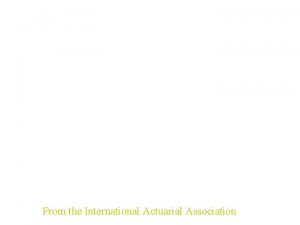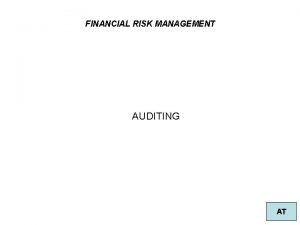Risk Management of Financial Institutions after the Financial










- Slides: 10

Risk Management of Financial Institutions after the Financial Tsunami---Current Reactions Hsien-hsing Liao Department of Finance National Taiwan University 1

Contents The financial failure 2007 -? Basel III Some points from “NYU Stern Working Group on Financial Reform” 2

Understanding financial failure (G 20, June 2010, Toronto ) • Originate-to-distribute model: complex derivatives, but simple maturity mismatches • Leverage and deleveraging cycle (Minsky-moment) • Contagion cycle: financial real political • Contagion: liquidity solvency Amplifiers • Endogenous risk (behavioural) • Counterparty risks • Off-balance sheet, contingent lines - paradox of trust • Excess reliance on ‘wholesale’ finance

Broad principles underlying reform and regulatory change (G 20, June 2010, Toronto ) • Undercapitalized financial system • Limits of micro-prudential (individual) rationality in regulation, supervision • Limit size, complexity, in some cases interconnectivity of financial institutions. • Risk allocation • Ex-ante incentives (bail-in) vs. ex-post (bail-out, levy, taxes) • Continuous markets (risk pricing, market clearing, basic transformation functions – ‘market-maker of last resort’)

Summary: status of core issues High conceptual clarity Capital adequacy; capital standards ; trading book High/reasonable prospect (with changes; leverage ratios; liquidity ratios; modifications) countercyclical buffers High level consensus Reasonable conceptual clarity Reasonable prospect (in some jurisdictions more than others) Some consensus Charges on SIFI; other macro-prudential systemic risk measures – FAT, FSC (IMF); Financial Crisis Responsibility (FCR) fee (Obama-TARP levy 0. 15% of LFI liabilities); market stabilization fund (Germany, US); bonus/payroll taxes (UK, France) Resolution plans –living wills; Volcker-rule Basic concept, low clarity Uncertain prospects No consensus Cross-border resolution regime- its link with national measures (punitive charges, stability funds); bank-tax/levy; FTT/CTT

Basel III • The Basel Committee on Banking Supervision reached board “Basel III” agreement on 12 Sep. 2010 • “Basel III” tightens the definition of regulatory capital; • increases the min. requirement of Tier 1 Capital; • establishes conservation / countercyclical capital buffers; • introduces a leverage ratio; • a new liquidity coverage ratio and a net stable 6

Basel III Proposed Capital Reforms • Quality, consistency & transparency of • • the capital base. Enhance risk coverage. Introduce a leverage ratio. Deal with Pro-cyclicality. Address systemic risk & interconnectedness.

NYU Stern Working Group on Financial Reform Financial Architecture If the financial system continues to be dominated by institutions with high levels of systemic risk: n The creation of a new systemic risk regulator is necessary n This new regulator would supervise the growing cohort of financial conglomerates n institutions are encouraged to follow more specialized business strategies. 8

Systematic Risk • • • Measuring Systemic Risk Managing Systemic Risk Taxing Too-Big-to-Fail Institutions Capital and Liquidity Requirements Is Breaking Up the Big Financial Companies a Good Idea? Size or activities • Contingent Capital • Financial Institutions Subject to the Bankruptcy Code 9

Markets and Institutions Securtization reforms Securitization created serious systemic problems that played a major role in the financial crisis. n Transparency n More Regulations vs. Cost Efficiency Credit Agencies central players in the subprime residential mortgage crisis 10
 Enterprise risk management for financial institutions
Enterprise risk management for financial institutions Key risk indicators template
Key risk indicators template After me after me after me
After me after me after me If anyone desires to come after me
If anyone desires to come after me Management of financial institutions daibb pdf
Management of financial institutions daibb pdf Liquidity measures
Liquidity measures Business risk vs financial risk capital structure
Business risk vs financial risk capital structure Risk map risk management
Risk map risk management Financial markets and institutions chapter 1
Financial markets and institutions chapter 1 Money market participants
Money market participants Functions of financial institutions
Functions of financial institutions



















